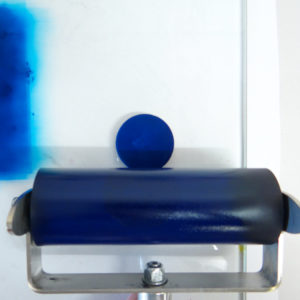I am a printmaker based in Bude in North Cornwall. I make print editions centred round themes of food, still life imagery and the domestic everyday.

Describe your printmaking process.
At the moment I am working mainly in linocut but I also use alternative ways to reproduce my images by making adaptations to the traditional print processes.
I switch between the 2 methods and both inform one another.

How and where did you learn to print?
While studying Graphic Design in Manchester I discovered the Screen Printing workshop and I was hooked on printmaking from then on. I specialised in Printmaking
at the Royal College of Art for 2 years where I began exploring alternative printmaking processes.

Why printmaking?
I love repetition! I am totally attracted to images on repeat. The physical process behind a successful repeat is also really appealing to me. I really
enjoy the problem solving and mechanics behind producing a print edition.

Where do you work?
I use a small workshop just down the coast from Bude, kind of in someone’s garden, amongst the vegetable patch! It’s a simple set-up; I have a home-made
press, and an inking up and drying area, it works perfectly. If I’m just cutting lino I sometimes work on the kitchen table at home, especially when
it’s chilly in the winter.

Describe a typical day in your studio.
I am also a post lady, so my day actually begins in the sorting office! Once the post is delivered by early afternoon I am free for printmaking for the
rest of the day. I have to plan ahead and work out the afternoon’s task the day before otherwise the afternoon just drifts away and I get nothing done.
In the early stages of a project, I am drawing, generating ideas and mapping out images. Once the printing process begins it’s a really different working
pace. Having limited time adds an extra element of excitement to the process! I am often racing against daylight to mix the right colour or to complete
a print edition so there is enough drying time before an exhibition.

How long have you been printmaking?
It’s 10 years since I first discovered Printmaking on my Graphic Design degree but I would say it’s been 6 years doing it reasonably seriously and while
exhibiting regularly.

What inspires you?
The everyday. Daily domestic life, family homes and fruit and vegetable shops are all big inspiration for me. I also love cottage industry and small-scale
mass-production, which influences my own reproduction processes.

What is your favourite printmaking product?
Flexcut Slipstrop, I still need
a bit of practice but it’s showing great potential for keeping my tools sharp!

What have you made that you are most proud of?
I think my ‘Courgette Shop’ project was one of the most ridiculous and challenging projects I have ever set myself. It’s become a bit of a storage problem
now but I’m still pretty proud that I hand-painted 2800 toilet rolls under some tough time constraints!

Where can we see your work? Where do you sell?
I am about to take part in a 3-person show on lino cuts at ‘The Hybrid Gallery’ in Honiton and I currently have work for sale in ‘The Workshop’, Bude as
well as on my online shop. You can follow my process on Instagram and any upcoming venues are posted on here too.

What will we be seeing from you next?
I am about to go on an artist residency in a rural village in Nepal to research subsistence farming techniques, so a new body of work is around the corner!
The next 12 months look set to be exciting for me and my work.

Do you have any advice for other printmakers and creatives?
Work hard and be patient! It’s a roller-coaster and I’m very much still riding it! Keep making even if you’re not sure about it, you need to get through
the bad ideas before you get to the good stuff. I’m still trying to get there too!
To see more of Helen’s amazing work, visit her website: helenmurgatroyd.co.uk































